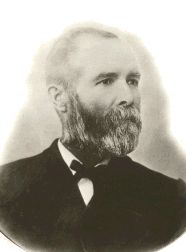"Bigamy is having one wife too many. Monogamy is the same."
-- Oscar Wilde

The Mormon missionary to Mexico, Helaman Pratt, was the grandfather of Michigan governor and presidential candidate, George Wilcken Romney. And he was the great-grandfather of Massachusetts governor and presidential candidate, Mitt.
One fine day in the spring of 1874, Helaman Pratt married Anna Johanna Dorothea Wilcken in Salt Lake City. He had already married Emeline Billingsley, and he would go on to marry Bertha Christine Wilcken. He became the father of 27 children, at least.
A funny thing about Mormons is that they used to be polygamists. Helaman Pratt was a polygamist -- from the Greek polus, for "many," and gamoi, for "marriages." Helaman Pratt was a polygynist, too -- from the Greek polus, for "many," and gynaikes, for "women." Polygamy -- having many wives -- is not so common. Polygyny -- having many women -- is all over the place.
We know a few polygynists in this country. Bill Clinton had more than one woman in the White House. Arnold Schwarzenegger had more than one woman at home in Brentwood. John Edwards had a woman on the campaign trail; Mark Sanford did not have a woman on the Appalachian Trail, but he had one in Argentina. Al Gore had a masseuse in Oregon, but was rebuffed. And Anthony Weiner had more than one woman online -- which made him a virtual polygynist, I guess.
We know other polygynists abroad. We know the Italian Prime Minister and AC Milan owner, Silvio Berlusconi, who Bunga Bungas with Moroccan teenage dancers. We know Israel's former President, Moshe Katsav, who appealed charges of sexual harassment and rape last week. And we know DSK, the old IMF chief -- who was not abroad when he allegedly assaulted Nafissatou Diallo at a hotel in New York.
Horse farmers are familiar with polygynists. Secretariat, who in 1973 won the Triple Crown, sired as many as 600 foals. Cattle farmers, goat farmers, Bactrian camel farmers and yak farmers are familiar with polygynous males; and undomesticated animals are polygynous as well. When the sociologist, Lee Ellis, reviewed hundreds of studies of rodents, ungulates, primates and other mammals in 1995, he found that dominant males have sex with more females, in almost every case.
The annals of history are all about politics and sex. The anthropologist, Elman Service, argued that civilization has risen up independently, more or less, 6 times: in the Near East, in Egypt, in India, in China, in Mesoamerica and in Peru. The heads of every one of those civilizations was a polygynist -- they had sex with whole bunches of women. But the heads of every one of those civilizations was a monogamist, too -- they were married to just one wife.
Which makes sense, because marriage is about the inheritance of wealth, but mating is about the inheritance of genes. Monogamy is all about consolidating assets. Polygyny is all about copying DNA.
So emperors were habitually monogamous: they married one wife at a time. Inca emperors kept one coya, usually a half-sister, as their "First Woman," the mothers of their only heirs. Aztec emperors kept a single "asked-for woman." In India, every maharaja, or great king, had a majarani, or great queen -- however many ranis followed. And even before China became an empire, the Zhouli, or Rites of Zhou, told kings to keep one queen -- along with 3, 9, 27 or 81 consorts of various ranks. Egyptian Pharaohs kept a lone "Great Wife." And in the Near East, as early as the Code of Hammurabi, men married one woman, who gave them one heir, and kept secondary wives and plenty of slaves on the side.
Because emperors were habitually polygynous: they had sex with ridiculous numbers of women. Inca emperors had access to "houses of virgins," with 1500 women in each, in every principal province. Aztec emperors like Montezuma II, who met Cortés, hid away thousands of concubines, guarded by old women and dwarves. In India, Kautilya's Arthashastra and Vatsayana's Kamasutra talk about parapet surrounded residences for princes and princesses, maternity wards, and quarters for thousands of consorts. And in China, dynastic histories give Han emperors thousands of women, and Sui emperors 100,000. Pharaohs in New Kingdom Egypt collected hundreds of women, and fathered hundreds of sons; and Near Eastern emperors kept a different girl for every day of the year -- before they were taken over by Alexander.
The bad thing about polygamy, after the fashion Helaman Pratt and other Mormons, is that it tends to dissipate wealth. Households are apt to break up, and nobody gets rich off an inheritance.
Which is why, in a political sense, polygyny is much worse. If roughly one woman is born for every one man, then any man who has sex with a thousand women leaves 999 men alone. Polygynists have to be greedy, to support their families. And they have to be mean. It takes a despot to defend a compound full of women and children, when so many poor and oppressed subjects are left without.
Link:
http://www.nytimes.com/2014/11/11/us/its-official-mormon-founder-had-up…
Lit:
Ellis, Lee. 1995. Dominance and reproductive success among nonhuman animals. Ethology and Sociobiology 16: 257-333.
Service, Elman. 1975. The Origins of the State and Civilization. New York: Norton.
Betzig, Laura 1992. Roman polygyny. Ethology and Sociobiology, 13: 309-49. PDF file
Betzig, Laura. 1992. Roman monogamy. Ethology and Sociobiology, 13: 351-83. PDF file




